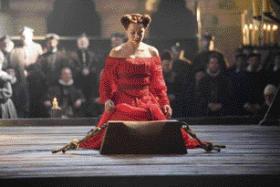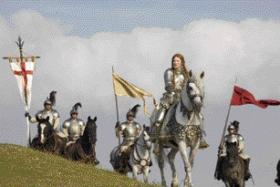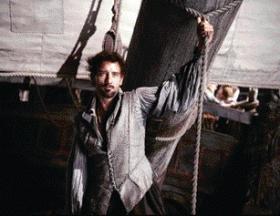Film Eye
Published in Early Modern History (1500–1700), Issue 1 (Jan/Feb 2008), Reviews, Volume 16Elizabeth’s only adviser and policy-maker shown in the film is Sir Francis Walsingham (Geoffrey Rush).
History as fairytale?
Elizabeth: the Golden Age
Director: Shekhar Kapur
by Hiram Morgan
Director: Zack Synder
by Ciarán Brady
This film is great fun but it is not history. It is an Anglo-Protestant present-centred interpretation of history wrapped up in Hollywood glamour, Harry Potter fantasy and Monty Python caricature. It is a sequel to the 1998 production (also starring Cate Blanchett) about the early years of Elizabeth’s reign. This one deals with the second half of the 1580s, when the Spanish Armada was launched against England. One wonders whether this will end up as a trilogy with a remake of The private lives of Elizabeth and Essex.
The director, Shekhar Kapur, and his writers, William Nicholson and Michael Hurst, have taken artistic licence to new heights in driving their narrative. Indeed, spotting their historical howlers is part of the fun. For instance, in real life Elizabeth, unlike Blanchett, was already in her fifties. Nor was she still able to consider marriage proposals and manipulate foreign suitors as depicted here. From the screenwriters’ point of view, one can see the obvious need to simplify the complexities of history in order to tell a story, but this smacks of ‘dumbing down’. Elizabeth’s only adviser and policy-maker shown here is Sir Francis Walsingham; there is no mention of other privy councillors such as Leicester, Heneage and, most importantly of all, William Cecil, Lord Burghley, the lord high treasurer of England. Elizabeth has only one lady-in-waiting, Bess Throckmorton, whereas in reality a large staff of such noblewomen attended upon the queen. In the film there is only one courtier, Sir Walter Raleigh. What about the ‘dancing chancellor’, Sir Christopher Hatton, who had the pet name ‘Mouton’, or her Irish favourite, Black Tom, earl of Ormond, whom she nicknamed ‘Sweet Lucas’? Raleigh (who is romancing the queen whilst at the same time impregnating her handmaiden) is likewise shown as the only ‘seadog’ responsible for attacking the Spanish Main; there is no mention of Drake’s role in this long-distance piracy perpetrated against Spain in the New World. It is with this mistake that the simplified dramatis personae falls down as a narrative device. The excessive concentration on Raleigh has serious consequences when the film comes to portray the Armada’s advance up the Channel. Raleigh as a result has to be given an exaggerated role (guiding a fire-ship and then diving off it at the last minute), even though it is unclear from the historical record what part, if any, he played in the battle.

The execution of Mary Queen of Scots (Samantha Morton) is a lost opportunity for both gore and sentimentality. In real life her beheading took three chops of the axe and ended bizarrely with her lapdogs emerging from beneath her dress.
Drake, the real architect of victory, is belatedly parachuted into the film at this point and given half a line or two at best. Messy.
Not only do the characters get reduced in number, but the action gets bowdlerised and causation goes out the window entirely. The Throckmorton and Babington plots against Elizabeth, which involved Mary Queen of Scots, are hopelessly mixed up and both confused with the Parry assassination attempt. The subsequent execution of the Scottish queen, who is altogether more sexy here than the virgin queen, is a lost opportunity for both gore and sentimentality. In real life her beheading was not so clean-cut: it was a ham-fisted business that took three chops of the axe and ended bizarrely with her lapdogs emerging from beneath her dress. Furthermore, the main cause of the war with Spain—the revolt of the Netherlands against Spain and Philip’s attempt to reconquer those rebel provinces—is never mentioned. England did not want—as she again feared in Napoleonic times and in two world wars—a great power dominating the near continent. According to this film, the causes of the conflict were the exploitation of the New World and differences over religion, not geo-political fears. Altogether too much is made of Raleigh’s attempted colony in Virginia, potatoes and tobacco. There is no evidence that the queen had the least interest in these things. She was not a self-conscious imperialist. Feisty maybe, but an heirless, beleaguered head of state all the same. There is no mention of Raleigh’s activities in Ireland—his role in the massacre at Smerwick or the plantation of Cork. Indeed, there is no mention of Ireland—Elizabeth’s own rebel realm—at all, even though conquering it cost England under Elizabeth more than intervening in the Dutch wars and fending off the Armada put together. Also, though this may have been the high point of Elizabeth’s reign, the film conveniently forgets the fifteen years of war, penury and death that ensued until James, the son of Mary Queen of Scots, ascended the throne and stopped the war against Spain.

At Tilbury Elizabeth (Cate Blanchett) is dressed more like a ’70s rock star, on a horse she is clearly unable to control and making a speech that no one could possibly have heard.
Catholic and Spanish critics of the film are entirely justified in their complaints about its gross caricature of Philip II, the Jesuits and the Counter-Reformation. Indeed, the Spanish ambassador and his entourage at Elizabeth’s court swish about in unison like the Spanish Inquisition gag from Monty Python. They were one side of the religious-rent Europe; there are no ranting, thick-vowelled Protestant preachers depicted on the English side (as there definitely were) to provide balance. The film does go some way towards showing the issue of families divided by religion in England—the queen’s lady-in-waiting betrays a relative, and Walsingham is given a Catholic brother who is tortured along with other conspirators. It does get right much of the queen’s own psychology. But whatever she herself may have thought about tolerating Catholics, her’s was still a far cry from being a religiously tolerant state; that hypocritical myth was exposed time and again when it had to deal with its neighbouring dependency—the mainly Catholic island of Ireland.
The other annoying thing about this film is its staging. The costumers do make great use of the portraits of Elizabeth to fit out Cate Blanchett in brilliant clothes, but some of the scenes are plain daft. At Tilbury Elizabeth is dressed (homage to Joan of Arc films notwithstanding) more like a ’70s rock star, she is on a horse she is clearly unable to control, and making a speech that no one could possibly have heard. It is plain that when making the Armada battle scenes the film-makers had only one seaworthy galleon—the rest is graphics, and transparently fake at that. Mary Stuart broods away in a Highland-style lochside castle, even though her place of confinement was Fotheringay Castle in Northamptonshire. The East Anglian churches and Cambridge colleges used for Elizabeth’s palaces give the film more of a Gothic than a Tudor look. The long shots in these are altogether more reminiscent of Harry Potter. The queen’s interviews with John Dee are more like a discussion with Dumbledore than with England’s leading intellectual. One only has to see the ‘mirror on the wall’ scene and think ‘fairytale’!
Hiram Morgan lectures in history at University College Cork.

Sir Walter Raleigh (Clive Owen) is given an exaggerated role in the defeat of the Armada. Sir Francis Drake, the real architect of victory, is belatedly parachuted in and given a line or two at best.
















